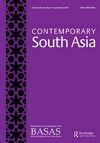Popular geopolitics of ‘nuclear India’: tracing the evolution of India’s ‘regional’ and ‘global’ identities in the English daily The Hindu from 2011–2020
IF 0.8
3区 社会学
Q3 AREA STUDIES
引用次数: 0
Abstract
Conventional wisdom on India’s nuclear geopolitics takes a top-down approach, foregrounding state perceptions of India’s nuclear role in regional and global politics. This conventional approach overlooks the bottom-up processes, such as media representations, which have been fundamental in shaping India’s nuclear identity. This is because media representations comprise common-sense knowledge, since media is the primary source of information in a democracy. Building on theoretical underpinnings of popular geopolitics, this article focuses on analyses of media representations in the Editorial of the English daily The Hindu from 2011–2020. This national newspaper boasts the second-largest readership among English dailies. The direct link between The Hindu Editorial’s representations of ‘nuclear India’ and India’s ‘regional’ and ‘global’ selfhood is crucial. The concerned period of 2011–2020 was pivotal in charting Indian geopolitical identity, as India partook in international negotiations after the US-India Nuclear Deal in 2008 and became a member of multilateral export control regimes like the Wassenaar Arrangement, Australia Group, and Missile Technology Control Regime. This article deconstructs the Editorial texts to elicit the intertextual links underpinning the ‘geopolitical cultural signifier’, ‘geospatial mythology’, and ‘self/other’ binary representation that operationalises India’s nuclear identity in regional and global settings.“核印度”的流行地缘政治:2011-2020年英国《印度教徒报》追踪印度“地区”和“全球”身份的演变
关于印度核地缘政治的传统智慧采取自上而下的方法,突出了国家对印度在地区和全球政治中的核角色的看法。这种传统方法忽视了自下而上的过程,比如媒体报道,而这些过程在塑造印度的核身份方面起着至关重要的作用。这是因为媒体代表包含常识,因为媒体是民主国家信息的主要来源。本文以流行地缘政治的理论基础为基础,重点分析了2011-2020年英国《印度教徒报》社论中的媒体表征。这份全国性报纸的读者群在英文日报中排名第二。《印度教徒社论》对“核印度”的表述与印度的“地区”和“全球”自我之间的直接联系至关重要。2011-2020年是印度地缘政治认同的关键时期,因为印度在2008年美印核协议后参与了国际谈判,并成为瓦森纳安排、澳大利亚集团和导弹技术控制制度等多边出口管制机制的成员。本文解构了社论文本,以引出支撑“地缘政治文化能指”、“地理空间神话”和“自我/他者”二元表征的互文联系,这些二元表征在区域和全球环境中实现了印度的核心身份。
本文章由计算机程序翻译,如有差异,请以英文原文为准。
求助全文
约1分钟内获得全文
求助全文
来源期刊

Contemporary South Asia
AREA STUDIES-
CiteScore
2.10
自引率
0.00%
发文量
82
期刊介绍:
The countries of South Asia - Bangladesh, Bhutan, India, Maldives, Nepal, Pakistan and Sri Lanka - are internally diverse and part of global flows of people, goods and ideas. Contemporary South Asia seeks to address the issues of the region by presenting research and analysis which is both cross-regional and multi-disciplinary. The journal encourages the development of new perspectives on the study of South Asia from across the arts and social sciences disciplines. We also welcome contributions to pan-regional and inter-disciplinary analysis. Our aim is to create a vibrant research space to explore the multidimensional issues of concern to scholars working on South Asia and South Asian diasporas in the postcolonial era.
 求助内容:
求助内容: 应助结果提醒方式:
应助结果提醒方式:


